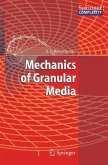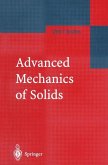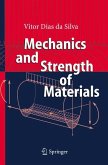- Broschiertes Buch
- Merkliste
- Auf die Merkliste
- Bewerten Bewerten
- Teilen
- Produkt teilen
- Produkterinnerung
- Produkterinnerung
Porous media theories play an important role in many branches of engineering, including material science, the petroleum industry, chemical engineering, and soil mechanics, as well as biomechanics. This book offers a consistent treatment of the material-independent fundamental equations of the theory of porous media, formulates constitutive equations for frictional materials in the elastic and plastic range, and traces the historical development of porous media theory. Thus, for the first time, a unique treatment of fluid-saturated porous solids is presented. The corresponding theory is…mehr
Andere Kunden interessierten sich auch für
![Porous Media Porous Media]() Porous Media112,99 €
Porous Media112,99 €![Mechanics of Granular Media Mechanics of Granular Media]() Aleksandr F. RevuzhenkoMechanics of Granular Media112,99 €
Aleksandr F. RevuzhenkoMechanics of Granular Media112,99 €![Advanced Mechanics of Solids Advanced Mechanics of Solids]() Otto T. BruhnsAdvanced Mechanics of Solids38,99 €
Otto T. BruhnsAdvanced Mechanics of Solids38,99 €![Convection in Porous Media Convection in Porous Media]() Donald A. NieldConvection in Porous Media261,99 €
Donald A. NieldConvection in Porous Media261,99 €![Transport Processes in Porous Media Transport Processes in Porous Media]() Frank A. CoutelierisTransport Processes in Porous Media75,99 €
Frank A. CoutelierisTransport Processes in Porous Media75,99 €![Elastoplasticity Theory Elastoplasticity Theory]() Koichi HashiguchiElastoplasticity Theory130,99 €
Koichi HashiguchiElastoplasticity Theory130,99 €![Mechanics and Strength of Materials Mechanics and Strength of Materials]() Vitor Dias da SilvaMechanics and Strength of Materials99,98 €
Vitor Dias da SilvaMechanics and Strength of Materials99,98 €-
-
-
Porous media theories play an important role in many branches of engineering, including material science, the petroleum industry, chemical engineering, and soil mechanics, as well as biomechanics. This book offers a consistent treatment of the material-independent fundamental equations of the theory of porous media, formulates constitutive equations for frictional materials in the elastic and plastic range, and traces the historical development of porous media theory. Thus, for the first time, a unique treatment of fluid-saturated porous solids is presented. The corresponding theory is explained by its historical progression, and its current state is thoroughly described.
Produktdetails
- Produktdetails
- Verlag: Springer / Springer Berlin Heidelberg / Springer, Berlin
- Artikelnr. des Verlages: 978-3-642-64062-9
- Softcover reprint of the original 1st ed. 2000
- Seitenzahl: 640
- Erscheinungstermin: 18. September 2011
- Englisch
- Abmessung: 235mm x 155mm x 35mm
- Gewicht: 954g
- ISBN-13: 9783642640629
- ISBN-10: 3642640621
- Artikelnr.: 36114452
- Herstellerkennzeichnung
- Springer-Verlag GmbH
- Tiergartenstr. 17
- 69121 Heidelberg
- ProductSafety@springernature.com
- Verlag: Springer / Springer Berlin Heidelberg / Springer, Berlin
- Artikelnr. des Verlages: 978-3-642-64062-9
- Softcover reprint of the original 1st ed. 2000
- Seitenzahl: 640
- Erscheinungstermin: 18. September 2011
- Englisch
- Abmessung: 235mm x 155mm x 35mm
- Gewicht: 954g
- ISBN-13: 9783642640629
- ISBN-10: 3642640621
- Artikelnr.: 36114452
- Herstellerkennzeichnung
- Springer-Verlag GmbH
- Tiergartenstr. 17
- 69121 Heidelberg
- ProductSafety@springernature.com
1 Introduction.- 2 The Early Era.- 2.1 The Development of the Principles of Mechanics.- 2.2 The Dynamics of Rigid Bodies.- 2.3 The Theory of Ideal Fluids.- 2.4 Euler's Description of a Porous Body.- 2.5 Coulomb's Earth Pressure Theory.- 2.6 Woltman's Contribution to the Porous Media Theory: The Introduction of the Angle of Internal Friction and the Volume Fraction Concept.- 2.7 Concluding Remarks.- 2.8 Biographical Notes.- 3 The Classical Era.- 3.1 Cauchy's Formulation of the Stress Concept.- 3.2 The Development of the Linear Elasticity Theory.- 3.3 Discovery of Fundamental Laws (Delesse, Fick, Darcy).- 3.4 The Development of the Theory of Viscous Fluids.- 3.5 The Mohr-Coulomb Failure Condition and other Plasticity Theory Studies.- 3.6 Motion of Liquids in Rigid Porous Solids.- 3.7 Foundation of the Mixture Theory.- 3.8 The Foundation of Thermodynamics.- 4 The Modern Era.- 4.1 Discovery of Fundamental Effects of Liquid-Saturated Rigid Porous Solids.- 4.2 The Treatment of the Liquid-Saturated Deformable Porous Solid by von Terzaghi.- 4.3 The Foundation of Modern Porous Media Theory by Fillunger.- 4.4 The Tragic Controversy Between the Viennese Professors Fillunger and von Terzaghi in 1936/37.- 4.5 The Further Development of the Viennese Affair and in Soil Mechanics.- 4.6 Biographical Notes.- 4.7 The Followers of von Terzaghi and Fillunger: Biot, Heinrich and Frenkel.- 4.8 Further Development of the Elasticity and Plasticity Theories..- 4.9 Modern Continuum Mechanics and Mixture Theory.- 4.10 Theories of Immiscible Mixtures.- 5 Current State of Porous Media Theory.- 5.1 Introductory Remarks to Porous Media Theory.- 5.2 The Volume Fraction Concept.- 5.3 Kinematics.- 5.4 Balance Equations.- 5.5 Entropy Inequality.- 5.6 The Closure Problem and the SaturationConstraint.- 5.7 Principle of Virtual Work.- 5.8 Constitutive Theory.- 5.9 Applications.- 6 Conclusions and Outlook.- A Evaluation of the Entropy Inequality.- B Introduction to the Vector- and Tensor Calculus for Engineers.- B 1. Introduction.- B 2. Basic Concepts.- B 2.1 Symbols.- B 2.2 Einstein's Summation Convention.- B 2.3 Kronecker Symbol.- B 3. Vector Algebra.- B 3.1 Vector Notion and Vector Operations.- B 3.2 Base System.- B 3.3 Reciprocal Base System.- B 3.4 Covariant and Contravariant Coefficients of the Vector Components.- B 3.5 Physical Coefficients of a Vector.- B 4. Tensor Algebra.- B 4.1 Tensor Notion (Linear Mapping).- B 4.2 Algebra in Base Systems.- B 4.3 Scalar Product of Tensors.- B 4.4 Tensor Product.- B 4.5 Special Tensors and Operations.- B 4.5.1 Inverse Tensor..- B 4.5.2 Transposed Tensor.- B 4.5.3 Symmetrical and Skew-Symmetrical Tensors..- B 4.5.4 Orthogonal Tensor.- B 4.5.5 Trace of the Tensor.- B 4.6 Decomposition of the Tensor.- B 4.6.1 Additive Decomposition.- B 4.6.2 Multiplicative Decomposition (Polar Decomposition).- B 4.7 Change of the Base.- B 4.8 Higher-Order Tensors.- B 4.8.1 Introduction of Higher-Order Tensors.....- B 4.8.2 Special Operations and Tensors.- B 4.8.3 Algebra in Base Systems.- B 4.9 Cross Product.- B 4.9.1 Cross Product of Vectors.- B 4.9.2 Cross Tensor Product of Vector and Tensor..- B 4.9.3 Cross Tensor Product of Tensors.- B 4.9.4 Cross Vector Product of Tensors.- B 4.9.5 Special Tensors and Operations.- B 4.10 Fundamental Tensors.- B 5. Vector and Tensor Analysis.- B 5.1 Functions of Scalar Parameters.- B 5.2 Field Theory.- B 5.2.1 Gradient.- B 5.2.2 Derivatives of Higher-Order.- B 5.2.3 Special Operations (Divergence, Rotation, and the Laplace-Operator).- B 5.3 Functions of Vector and Tensor Variables.- B 5.4Integral Theorems.- B 5.4.1 Transformation of Surface Integrals into Volume Integrals.- B 5.4.2 Transformation of Line Integrals into Surface Integrals.- C Geometric Representation of the Principal Stresses, the Stress Invariants and the Mohr-Coulomb Theory.- C 1. Preliminaries.- C 2. Triaxial Plane.- C 3. Octahedral Plane.- C 4. Geometric Representation of Yield Functions.- C 5. Subspace of the Stress State.- C 6. Mohr-Coulomb Theory.- C 6.1 Coulomb's Strength Hypothesis for Arbitrarily Oriented Surfaces.- C 6.2 Failure Surfaces.- C 7. Failure Condition in Invariant Formulation.- References.- Author Index.
1 Introduction.- 2 The Early Era.- 2.1 The Development of the Principles of Mechanics.- 2.2 The Dynamics of Rigid Bodies.- 2.3 The Theory of Ideal Fluids.- 2.4 Euler's Description of a Porous Body.- 2.5 Coulomb's Earth Pressure Theory.- 2.6 Woltman's Contribution to the Porous Media Theory: The Introduction of the Angle of Internal Friction and the Volume Fraction Concept.- 2.7 Concluding Remarks.- 2.8 Biographical Notes.- 3 The Classical Era.- 3.1 Cauchy's Formulation of the Stress Concept.- 3.2 The Development of the Linear Elasticity Theory.- 3.3 Discovery of Fundamental Laws (Delesse, Fick, Darcy).- 3.4 The Development of the Theory of Viscous Fluids.- 3.5 The Mohr-Coulomb Failure Condition and other Plasticity Theory Studies.- 3.6 Motion of Liquids in Rigid Porous Solids.- 3.7 Foundation of the Mixture Theory.- 3.8 The Foundation of Thermodynamics.- 4 The Modern Era.- 4.1 Discovery of Fundamental Effects of Liquid-Saturated Rigid Porous Solids.- 4.2 The Treatment of the Liquid-Saturated Deformable Porous Solid by von Terzaghi.- 4.3 The Foundation of Modern Porous Media Theory by Fillunger.- 4.4 The Tragic Controversy Between the Viennese Professors Fillunger and von Terzaghi in 1936/37.- 4.5 The Further Development of the Viennese Affair and in Soil Mechanics.- 4.6 Biographical Notes.- 4.7 The Followers of von Terzaghi and Fillunger: Biot, Heinrich and Frenkel.- 4.8 Further Development of the Elasticity and Plasticity Theories..- 4.9 Modern Continuum Mechanics and Mixture Theory.- 4.10 Theories of Immiscible Mixtures.- 5 Current State of Porous Media Theory.- 5.1 Introductory Remarks to Porous Media Theory.- 5.2 The Volume Fraction Concept.- 5.3 Kinematics.- 5.4 Balance Equations.- 5.5 Entropy Inequality.- 5.6 The Closure Problem and the SaturationConstraint.- 5.7 Principle of Virtual Work.- 5.8 Constitutive Theory.- 5.9 Applications.- 6 Conclusions and Outlook.- A Evaluation of the Entropy Inequality.- B Introduction to the Vector- and Tensor Calculus for Engineers.- B 1. Introduction.- B 2. Basic Concepts.- B 2.1 Symbols.- B 2.2 Einstein's Summation Convention.- B 2.3 Kronecker Symbol.- B 3. Vector Algebra.- B 3.1 Vector Notion and Vector Operations.- B 3.2 Base System.- B 3.3 Reciprocal Base System.- B 3.4 Covariant and Contravariant Coefficients of the Vector Components.- B 3.5 Physical Coefficients of a Vector.- B 4. Tensor Algebra.- B 4.1 Tensor Notion (Linear Mapping).- B 4.2 Algebra in Base Systems.- B 4.3 Scalar Product of Tensors.- B 4.4 Tensor Product.- B 4.5 Special Tensors and Operations.- B 4.5.1 Inverse Tensor..- B 4.5.2 Transposed Tensor.- B 4.5.3 Symmetrical and Skew-Symmetrical Tensors..- B 4.5.4 Orthogonal Tensor.- B 4.5.5 Trace of the Tensor.- B 4.6 Decomposition of the Tensor.- B 4.6.1 Additive Decomposition.- B 4.6.2 Multiplicative Decomposition (Polar Decomposition).- B 4.7 Change of the Base.- B 4.8 Higher-Order Tensors.- B 4.8.1 Introduction of Higher-Order Tensors.....- B 4.8.2 Special Operations and Tensors.- B 4.8.3 Algebra in Base Systems.- B 4.9 Cross Product.- B 4.9.1 Cross Product of Vectors.- B 4.9.2 Cross Tensor Product of Vector and Tensor..- B 4.9.3 Cross Tensor Product of Tensors.- B 4.9.4 Cross Vector Product of Tensors.- B 4.9.5 Special Tensors and Operations.- B 4.10 Fundamental Tensors.- B 5. Vector and Tensor Analysis.- B 5.1 Functions of Scalar Parameters.- B 5.2 Field Theory.- B 5.2.1 Gradient.- B 5.2.2 Derivatives of Higher-Order.- B 5.2.3 Special Operations (Divergence, Rotation, and the Laplace-Operator).- B 5.3 Functions of Vector and Tensor Variables.- B 5.4Integral Theorems.- B 5.4.1 Transformation of Surface Integrals into Volume Integrals.- B 5.4.2 Transformation of Line Integrals into Surface Integrals.- C Geometric Representation of the Principal Stresses, the Stress Invariants and the Mohr-Coulomb Theory.- C 1. Preliminaries.- C 2. Triaxial Plane.- C 3. Octahedral Plane.- C 4. Geometric Representation of Yield Functions.- C 5. Subspace of the Stress State.- C 6. Mohr-Coulomb Theory.- C 6.1 Coulomb's Strength Hypothesis for Arbitrarily Oriented Surfaces.- C 6.2 Failure Surfaces.- C 7. Failure Condition in Invariant Formulation.- References.- Author Index.









